![]()
![]()
![]()
Use LEFT and RIGHT arrow keys to navigate between flashcards;
Use UP and DOWN arrow keys to flip the card;
H to show hint;
A reads text to speech;
16 Cards in this Set
- Front
- Back
|
Anterior Fontanelle in newborns |
o Bulging – indicates increasedintracranial pressure o Depressed – indicatesdehydraton o Access for drawing CSF |
|
|
Posterior Fontanelle in newborns |
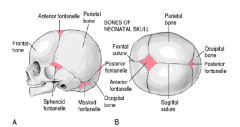
reference point for fetalhead during childbirth |
|
|
Anterolateral fontanelle |
sphenoid fontanelle |
|
|
Posterolateral |
mastoid fontanelle |
|
|
Adult skull and sutures |
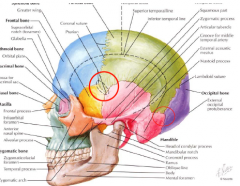
• Sutures: o Coronal: parietal + frontal bones o Squamous: parietal + temporalbones o Sagittal: R. + L. parietal o Lambdoid: parietal + occipitalbone • Bregma: sagittal and coronalsutures • Lambda: sagittal and lamboid sutures • Pterion: frontal, parietal,temporal and sphenoid • Asterion: temporal, parietal andoccipital |
|
|
frontal bone |
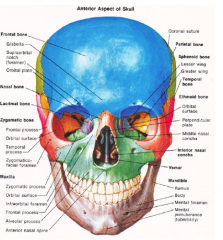
• Glabella: above arch of nose • Superciliary Arches: arches above obit (2) • Frontal Eminence: above the arches (2) • Supraorbital Foramen: supraorbital VAN • ANTERIOR CRANIAL FOSSA • Foramen Cecum |
|
|
occipital bone |
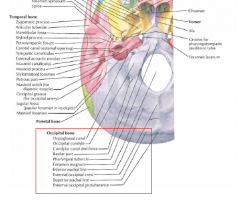
• External Occipital Protuberance (Inion) • Internal Occipital Protuberance • Superior and Inferior Nuchal Lines • Posterior Cranial Fossa • Occipital Condyles • Foramen magnum • Grooves for Dural Venous Sinus • Hypoglossal Canal: CN XII • Condylar Canal: occipital emissary v. • Jugular Foramen: shared with temporal |
|
|
temporal bone |
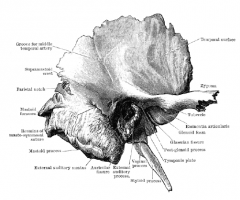
• Styloid Process • Mastoid Process • Glenoid Fossa • Digastric groove • External Acoustic Meatus • Stylomastoid Foramen: Facial N.,Stylomastoid A. • Petrotympanic Fissure: chordatympani n., anterior tympanic br.of maxillary a. |
|
|
temporal bone cont |
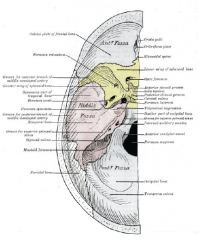
• Mastoid Canaliculus: auricular n. (X) • Tympanic Canaliculus: tympanic n. (IX) • Jugular Foramen: CN IX, X, XI, inferiorpetrosal sinus o Shared with occipital bone • Carotid Canal: Internal Carotid A., InternalCarotid Plexus • Foramen Lacerum: covered by cartilage o Shared with sphenoid bone • Internal Acoustic Meatus: CN VII, VIII,labyrinthine a. • Hiatus for Lesser + Greater Petrosal N. |
|
|
sphenoid bone |
• Central Body: sella turcica • Greater Wings: infratemporalcrest • Lesser Wings: forms part offloor of anterior cranial fossa • Pterygoid Processes: o Medial + lateral plate o Hamulus (medial plate) o Pterygoid Fossa o Scaphoid Fossa |
|
|
sphenoid bone and foramen |
• Contains 5 important openings: (1) Optic Canal: CN II (2) Superior Orbital Fissure: CN III, V1, IV, superior + inferioropthalamic v. (3) Foramen Rotundum: CN V2 (4) Foramen Ovale: CN V3 , Accessory meningeal a., lesserpetrosal n. (5) Foramen Spinosum: middle meningeal a., recurrentmeningeal n. |
|
|
ethmoid bone |
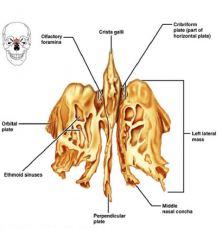
• Choana: posterior region of nasalseptum • Cribiform plate • Crista Galli • Superior and middle concha • Ethmoidal Foramina |
|
|
Mandible |
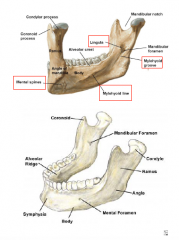
• Structure: o Coronoid Process, Condyle, Mand. Notch o Rami, Body, Angle o Alevolar Process o Mental Protuberance o Lingula o Superior/Inferior Genial Tubercles o Mylohyoid line + groove • Mandibular Foramen: InferiorAlveolar VAN • Mental Foramen: Mental VAN |
|
|
Maxilla |
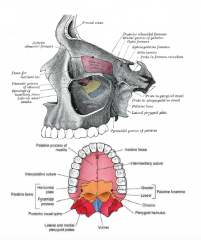
• Inferior Orbital Fissure: infraorbital VAN,zygomatic n., inferior opthalamic c. • Infraorbital Foramen: infraorbital VAN • Incisive Foramen: nasopalatine n. andsphenopalatine a. • Greater Palatine Canal: descendingpalatine VAN o Formed with palatine bone • Inferior and Middle Alveolar Canals • Max Sinus • Note: Hard palate = maxilla + palatinebones |
|
|
Zygomatic, Nasal, Vomer,Lacrimal, Inferior Nasal Concha |
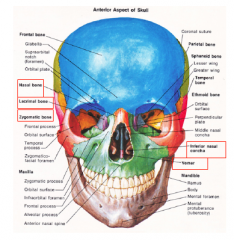
• Zygomatic Bones • Nasal Bones (Paired): o Nasion: where nasal bones meet facial • Lacrimal Bones: o Lacrimal Fossa: contains lacrimal sac • Vomer: o Nasal Septum = perpendicular plate +vomer + ethmoid cartilage • Inferior Nasal Concha (Paired): o Largest of the 3 concha |
|
|
Orbit and Nasal Cavity |
• Bones of Orbit: o Roof: lesser wing of sphenoid, frontal bone o Lateral: zygomatic, frontal, greater wing ofsphenoid o Medial: sphenoid body, ethmoid, lacrimal,maxilla o Floor: palatine, maxilla, zygomatic bone • Bones of Nasal Cavity: o Frontal, nasal, lacrimal, ethmoid, inferiornasal concha, sphenoid, palatine, maxilla |

